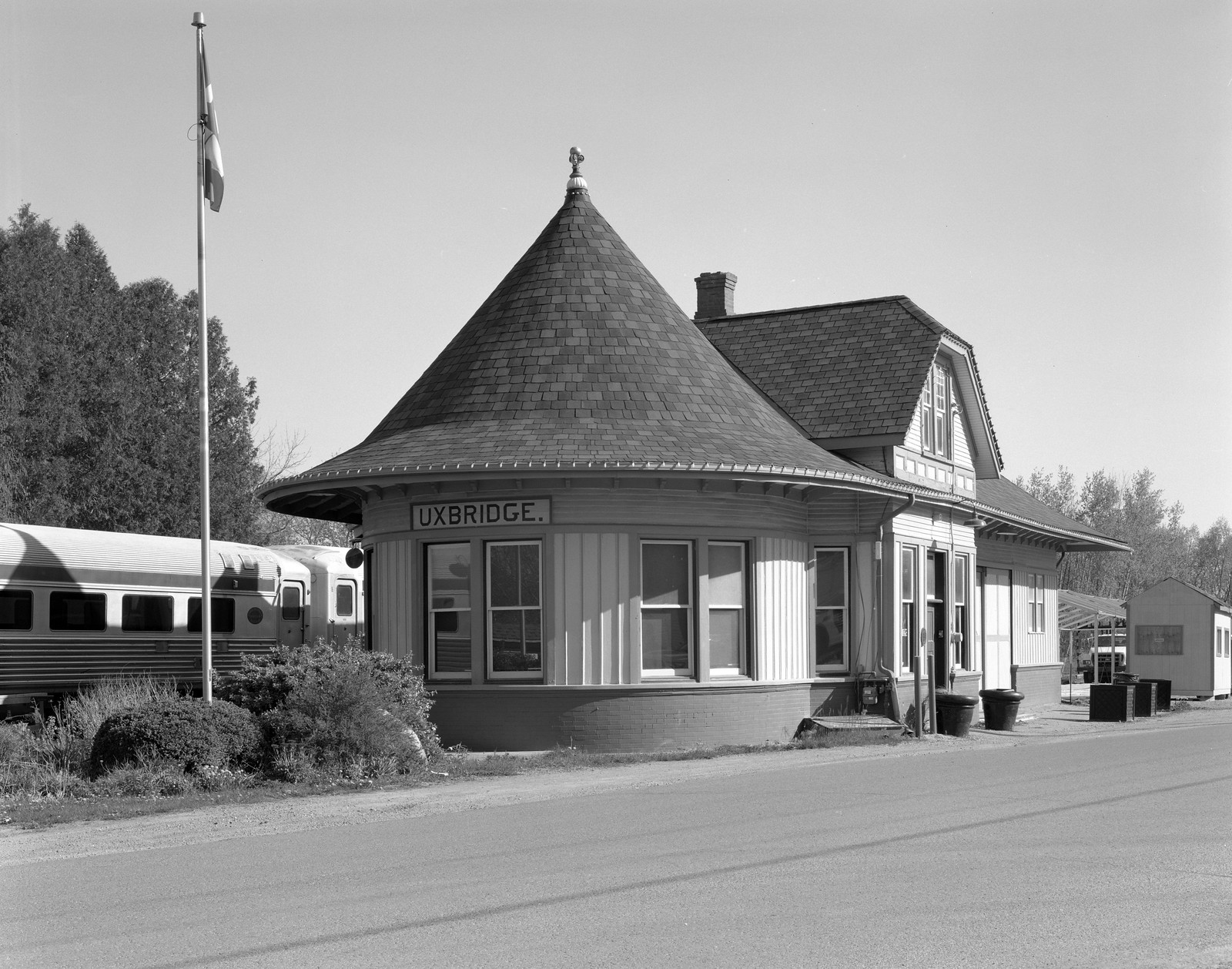When it comes to unique station styles in Canada, the one that stands out the most is the Witch’s Hat; these were popular among all significant railway operators through the early 20th Century. Sadly, there is only a handful left standing, but the only one still operates as a train station, which is the station at Uxbridge.

Crown Graphic – Nikon Nikkor-W 1:5.6/180 – Ilford HP5+ @ ASA-200 – Pyrocat-HD (1+1+100) 9:00 @ 20C
The first railway to arrive in Uxbridge was the Toronto & Nipissing Railway. A narrow-gauge line was chartered and supported by George Laidlaw to access the agricultural and timber resources in northern Ontario and access a potential transcontinental railway at Lake Nippissing. The line originating in Cannington started construction in 1869 but faced construction troubles heading south towards Toronto. Being situated on the second wedge of the Oak Ridges Moran, Uxbridge caused many ground quality issues for the railroad, but it would reach the small community in 1871. One of the biggest projects was a wooden timber bridge over the creek running through the town. A simple carpenter gothic shed style station was completed in 1869 along the rail right-of-way running near the town’s core. The station is similar to those found in Unionville and Markham; both survive today. In addition to the station, Toronto & Nipissing established their headquarters in Uxbridge and constructed small maintenance and switchyard, although their primary roundhouse remained in Toronto. Operations started in 1871, with the line reaching its northernmost point at Coboconk a year later. Finances and lack of interest saw the line extend beyond Coboconk instead of branching at Stouffville to Jackson Point at Lake Simcoe, which opened in 1875. Toronto & Nipissing in 1882 became a part of Midland Railway which in turn became part of Grand Trunk in 1893.

Nikon D750 – AF-S Nikkor 28-70mm 1:2.8D
Nikon D750 – AF-S Nikkor 28-70mm 1:2.8D
During Grand Trunk’s modernization project of the early 20th Century, while diminished, the railway yard at Uxbridge saw continued use by Grand Trunk. To recognize the importance and the status of Uxbridge as the area’s major urban centre, Grand Trunk decided to replace the old Toronto & Nippissing Station. The new station would feature a large baggage room, freight shed, and express office. There is a single general waiting room with a station master’s office and telegraph bay. The master’s office and telegraph bay sat in a round front section with a witch’s hat styling with the station carrying the Queen Anne Revival architectural style. The station began operations in 1904, with the original station being demolished shortly after. While constructed primarily of wooden board & batten, the foundation was pressed red brick. Canadian National continued to operate the station and yard when they took over in 1923. In the 1950s, Canadian National covered the station’s exterior walls and painted it a railroad red. Passenger service ceased in 1978, although Canadian National continued to operate the line for freight services and used the old station as an office. But the line had become redundant, and in 1987, operations ceased on both the line and the yard. Rather than let the station meet a wrecking ball, the town of Uxbridge purchased both the yard and station from Canadian National for a dollar in 1988.

Nikon D750 – AF-S Nikkor 28-70mm 1:2.8D
Nikon D750 – AF-S Nikkor 28-70mm 1:2.8D
But the town did little for the station, and in 1992 Canadian National tore up the tracks north of Uxbridge to Coboconk and sold the rail line south to GO Transit 1993, who retained the possibility of extending their line from Uxbridge from Stouffville. GO had started operating a commuter train to Stouffville in 1982 and ran buses to Uxbridge. Since 1987 a small group of railroad enthusiasts had been growing in Uxbridge with the desire to preserve the local rail heritage. The opening of the Port Stanley Terminal Railway encouraged the group to start their short-run heritage railway. The York-Durham Heritage Railway received its charter in 1993 and two years later took possession of its first functioning locomotive. Numbered 1310, a Montreal Locomotive Works built RS-3. Locomotive 1310 had rolled initially onto the tracks in 1954 for Ontario Northland before serving Abitibi-Price, who sold it to York-Durham. GO Transit agreed to lease the line between Uxbridge and Stouffville, allowing the group to run tourist trains after a dedicated station was completed at Stouffville in 1997. The group used the Uxbridge Grand Trunk station after restoration efforts. The station again was in jeopardy in 2013. Thankfully, the community rallied, and repair work again preserved the station. In 2015, extensive repair work maintained the 1872 wooden trestle bridge, which continues to be used as part of the Uxbridge rail trail. The York-Durham Heritage Railway operates its short line from Uxbridge to Stouffville, operating several mid-century road-switcher locomotives and various historic passenger cars. The old yard acts as the railway’s primary maintenance and storage yard. The 1872 bridge is also still standing in near original condition, which is one of the many walking trails through the community of Uxbridge.
Update – May 2022
On Saturday, 21 May 2022, a major storm blew through Ontario and Quebec. Right in the path of the storm destruction is the Uxbridge GTR station, which suffered major damage. The entire town suffered serious damage as a result of the storm. Please consider donating to the restoration effort through a GoFundMe campaign.
Update – January 2023
On Sunday, 21 January 2024, the York-Durham Heritage Railway announced it is filing for insolvency protection and ceasing all operations. While the heritage railway has stopped all operations, the station itself has reverted ownership back to the Town of Uxbridge. There are a lot of mixed feelings and information out there about this move. Please consider supporting any heritage railway operation in the province.